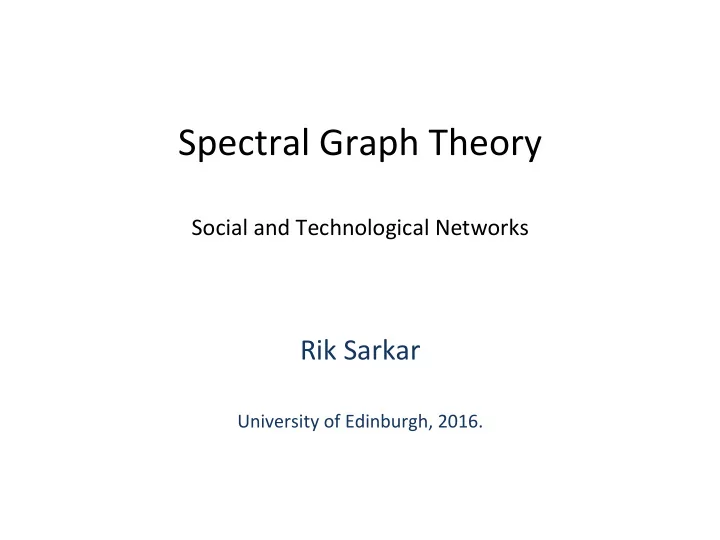

Spectral Graph Theory Social and Technological Networks Rik Sarkar University of Edinburgh, 2016.
Spectral methods • Understanding a graph using eigen values and eigen vectors of the matrix • We saw: • Ranks of web pages: components of 1st eigen vector of suitable matrix • Pagerank or HITS are algorithms designed to compute the eigen vector • Today: other ways spectral methods help in network analysis
Laplacian • L = D – A [D is the diagonal matrix of degrees] The image cannot be displayed. Your computer may not have enough memory to open the image, or the image may have been corrupted. Restart your computer, and then open the file again. If the red x still appears, you may have to delete the image and then insert it again. • An eigen vector has one value for each node • We are interested in properRes of these values
ApplicaRon 1: Drawing a graph • Problem: Computer does not know what a graph is supposed to look like • A graph is a jumble of edges • Consider a grid graph: • We want it drawn nicely
Graph embedding • Find posiRons for verRces of a graph in low dimension (compared to n) • Common objecRve: Preserve some properRes of the graph e.g. approximate distances between verRces – Useful in visualizaRon – Finding approximate distances • Using eigen vectors – One eigen vector gives x values of nodes – Other gives y-values of nodes … etc
Draw with v[1] and v[2] • Suppose v[0], v[1], v[2]… are eigen vectors – Sorted by increasing eigen values • Plot graph using X=v[1], Y=v[2] • Produces the grid
IntuiRons: the 1-D case • Suppose we take the jth eigen vector of a chain • What would that look like? • We are going to plot the chain along x-axis • The y axis will have the value of the node in the jth eigen vector • We want to see how these rise and fall
ObservaRons • j = 0 • j=1 • j=2 • j =3 • j = 19
For All j
ObservaRons • In Dim 1 grid: – v[1] is monotone – v[2] is not monotone • In dim 2 grid: – both v[1] and v[2] are monotone in suitable direcRons • For low values of j: – Nearby nodes have similar values • Useful for embedding
ApplicaRon 2: Colouring • Colouring: Assign colours to verRces, such that neighboring verRces do not have same colour – E.g. Assignment of radio channels to wireless nodes. Good colouring reduces interference • Idea: High eigen vectors give dissimilar values to nearby nodes • Use for colouring!
ApplicaRon 3: Cuts/segmentaRon/ clustering • Find the smallest ‘cut’ • A small set of edges whose removal disconnects the graph • Clustering, community detecRon…
Clustering/community detecRon • v[1] tends to stretch the narrow connecRons: discriminates different communiRes
Clustering: community detecRon • More communiRes • Need higher dimensions • Warning: it does not always work so cleanly • In this case, the data is very symmetric
Image segmentaRon Shi & malik ’00
Laplacian matrix • Imagine a small and different quanRty of heat at each node (say, in a metal mesh) • we write a funcRon u: u(i) = heat at i • This heat will spread through the mesh/graph • QuesRon: how much heat will each node have ajer a small amount of Rme? • “heat” can be representaRve of the probability of a random walk being there
Heat diffusion • Suppose nodes i and j are neighbors – How much heat will flow from i to j?
Heat diffusion • Suppose nodes i and j are neighbors • How much heat will flow from i to j? • ProporRonal to the gradient: – u(i) - u(j) – this is signed: negaRve means heat flows into i
Heat diffusion • If i has neighbors j1, j2…. • Then heat flowing out of i is: u(i) - u(j1) + u(i) - u(j2) + u(i) - u(j3) + … degree(i)*u(i) - u(j1) - u(j2) - u(j3) - …. • Hence L = D - A
The heat equaRon ∂ u ∂ t = L ( u ) • The net heat flow out of nodes in a Rme step • The change in heat distribuRon in a small Rme step – The rate of change of heat distribuRon
The smooth heat equaRon • The smooth Laplacian: • The smooth heat equaRon: ∆ f = ∂ f ∂ t
Heat flow • Will eventually converge of v[0] : the zeroth eigen vector, with eigen value λ 0 = 0 • v[0] is a constant: no more flow! v[0] = const
Laplacian • Changed implied by L on any input vector can be represented by sum of acRon of its eigen vectors (we saw this last Rme for MM T ) • v[0] is the slowest component of the change – With mulRplier λ 0 =0 • v[1] is slowest non-zero component – with mulRplier λ 1
Spectral gap • λ 1 – λ 0 • Determines the overall speed of change • If the slowest component v[1] changes fast – Then overall the values must be changing fast – Fast diffusion • If the slowest component is slow – Convergence will be slow • Examples: – Expanders have large spectral gaps – Grids and dumbbells have small gaps ~ 1/n
ApplicaRon 4: isomorphism tesRng • Eigen values different implies graphs are different • Though not necessarily the other way
Spectral methods • Wide applicability inside and outside networks • Related to many fundamental concepts – PCA – SVD • Random walks, diffusion, heat equaRon… • Results are good many Rmes, but not always • RelaRvely hard to give provable properRes • Inefficient: eig. computaRon costly on large matrix • (Somewhat) efficient methods exist for more restricted problems – e.g. when we want only a few smallest/largest eigen vectors
Recommend
More recommend